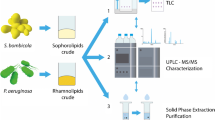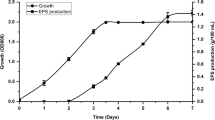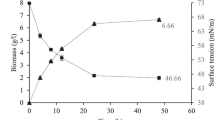Abstract
Sophorolipids (SLs) were produced by Starmerella bombicola. The separation and purification of SLs are a complex process, since they are produced as a mixture of compounds with few structural differences. Solvent extraction is commonly used in downstream processing. In this work, an environmental friendly approach was developed for SLs recovery and purification, based on neutral polymeric sorbents, Amberlite XAD16NTM, XAD18TM, and XAD1600NTM. In batch microassays, key parameters of sorption/desorption process (e.g., contact time, temperature, sorbents, and SLs concentrations) were optimized for separation of acidic and lactonic SLs. Sorption equilibrium was reached after 2–3 h, for all the sorbents tested. Among them XAD1600NTM showed a higher sorption capacity (q max 230 mg g−1), a higher removal (≈100 %) of acidic and lactonic SLs [1 and 2.5 % (w/v)], and the best selectivity. Methanol, ethanol, and acetone were suitable for SLs elution. A selective desorption of SLs was attained with acetonitrile aqueous solutions (v/v): (1) 25 % led to 88.3 % of acidic SLs and (2) 55 % followed by methanol solution (100 %) led to 93.2 % of purified lactonic SLs. This achievement was particularly important regarding SLs potential therapeutic applications, since acidic and lactonic SLs show different biologic activities. In fact, acid SLs show higher virucidal and pro-inflammatory cytokine activity, while lactonic SLs show stronger spermicidal and anti-cancer activity.






Similar content being viewed by others
References
Bogaert INAV, Saerens K, Muynck C, Develter DM, Soetaert W, Vandamme EJ (2007) Microbial production and application of sophorolipids. Appl Microbiol Biotechnol 76:23–34
Ashby RD, Solaiman DKY, Foglia TA (2006) The use of fatty acid esters to enhance free acid sophorolipid synthesis. Biotechnol Lett 28:253–260
Ribeiro IA, Bronze MR, Castro MC, Ribeiro MHL (2012) Optimization and correlation of HPLC-ELSD and HPLC-MS/MS methods for identification and characterization of sophorolipids. J Chromatogr B 899:72–80
Cavalero DA, Cooper DG (2003) The effect of medium composition on the structure and physical state of sophorolipids produced by Candida bombicola ATCC 22214. Appl Microbiol Biotechnol 103:31–41
Daniel HJ, Otto RT, Binder M, Reuss M, Syldatk C (1999) Production of sophorolipids from whey: development of a two-stage process with Cryptococcus curvatus ATCC 20509 and Candida bombicola ATCC 22214 using deproteinized whey concentrates as substrates. Appl Microbiol Biotechnol 51:40–45
Rau U, Hammen S, Heckmann R, Wray V, Lang S (2001) Sophorolipids: a source for novel compounds. Ind Crops Prod 13:85–92
Somasundaran P, Krishnakumar S (1997) Adsorption of surfactants and polymers at the solid-liquid interface. Colloid Surf A: Physicochem Eng Asp 123–124:491–513
Takayanagi H, Fukuda J, Miyata E (1996) Non-ionic adsorbents in separation processes. In: Verrall MS (ed) Downstream processing of natural products, a practical handbook. Willey, West Sussex, pp 159–177
Ramos AM, Otero M, Rodrigues AE (2005) Recovery of Vitamin B12 and cephalosporin-C from aqueous solutions by adsorption on non-ionic polymeric adsorbents. Sep Pur Technol 38:85–98
Ribeiro MHL, Ribeiro IAC (2005) Recovery of erythromycin from fermentation broth by adsorption onto neutral and ion-exchange resins. Sep Pur Technol 45:232–239
Dubey KV, Juwarkar AA, Singh SK (2005) Adsorption-desorption process using wood-based activated carbon for recovery of biosurfactant from fermented distillery wastewater. Biotechnol Prog 21:860–867
Heyd M, Kohnert A, Tan TH, Nusser M, Kirschhöfer F, Brenner-Weiss G, Franzreb M, Berensmeier S (2008) Development and trends of biosurfactant analysis and purification using rhamnolipids as an example. Anal Bioanal Chem 391:1579–1590
Rau U, Nguyenb LAH, Roeperc Kochc H, Langa S (2005) Downstream processing of mannosylerythritol lipids produced by Pseudozyma aphidis. Eur J Lipid Sci Technol 107:373–380
Zhang L, Somasundaran P, Singh SK, Felse AP, Gross R (2004) Synthesis and interfacial properties of sophorolipid derivatives. Colloid Surf A: Physicochem Eng Asp 240:75–82
Smyth TJP, Perfumo A, Marchant R, Banat IM (2010) Isolation and analysis of low molecular weight microbial glycolipids. In: Timmis KN (ed) Handbook of hydrocarbon and lipid microbiology. Springer-Verlag, Berlin, pp 3705–3722
Ribeiro IA, Bronze MR, Castro MF, Ribeiro MHL (2012) Sophorolipids: improvement of the selective production by Starmerella bombicola through the design of nutritional requirements. Appl Microbiol Biotechnol 97:1–13
Hu Y, Ju LK (2001) Purification of lactonic sophorolipids by crystallization. J Biotechnol 87:263–272
Baig KS, Doan HD, Wu J (2009) Multicomponent isotherms for biosorption of Ni2+ and Zn2+. Desalination 249:429–439
Conney DO (1999) Adsorption design for wastewater treatment. CRC Press, Boca Raton
Giles C, Smith D (1974) A general treatment and classification of the solute adsorption isotherm. J Colloid Interface Sci 47:755–765
Kammerer J, Carle R, Kammerer DR (2011) Adsorption and ion exchange: basic principles and their application in food processing. J Agric Food Chem 59:22–42
Shah V, Doncel GF, Seyoum T, Eaton KM, Zalenskaya I, Hagver R, Azim A, Gross R (2005) Sophorolipids, microbial glycolipids with anti-human immunodeficiency virus and sperm-immobilizing activities. Antimicrob Agents Chemother 49:4093–4100
Shao L, Song X, Ma X, Li H, Qu Y (2012) Bioactivties of sophorolipid with different structures against human esophageal cancer cells. J Surg Res 172:286–291
Acknowledgments
This research was supported by the Fundação Ciência e Tecnologia (FCT) strategic project: PEst-OE/SAU/UI4013/2011. The authors are grateful to FCT for funding the project REDE/1518/REM/2005 that allowed the HPLC–MS analysis.
Author information
Authors and Affiliations
Corresponding author
Rights and permissions
About this article
Cite this article
Ribeiro, I.A.C., Bronze, M.R., F. Castro, M. et al. Selective recovery of acidic and lactonic sophorolipids from culture broths towards the improvement of their therapeutic potential. Bioprocess Biosyst Eng 39, 1825–1837 (2016). https://doi.org/10.1007/s00449-016-1657-y
Received:
Accepted:
Published:
Issue Date:
DOI: https://doi.org/10.1007/s00449-016-1657-y




